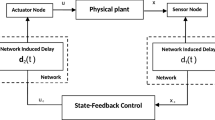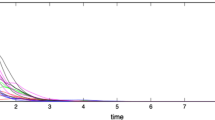Abstract
This paper investigates the problem of event-triggered \(H_\infty \) state estimation for switched genetic regulatory networks with static coupling via a sojourn-probability-dependent approach. The measurements of the network are evaluated by the event-triggers which are only undertaken at the switching times. By employing a time-delay approach, the estimation can be achieved by determining the exponential mean-square stability of the switched system with time-varying delay and known sojourn probability, while the system prescribes an \(H_\infty \) performance level. A co-design approach for the event-triggered mechanism and the estimators is presented by means of a novel Lyapunov–Krasovskii functional combining with refined Jensen-based inequalities. Finally, a numerical example is given to demonstrate the effectiveness of the designed estimators.







Similar content being viewed by others
References
A.D. Ames, P. Tabuada, S. Sastry, On the stability of zeno equilibria. Lecture notes in computer science. 3927, 34–48 (2006). Springer, Berlin
J. Cao, F. Ren, Exponential stability of discrete-time genetic regulatory networks with delays. IEEE Trans. Neural Netw. 19(3), 520–523 (2008)
J. Cao, R. Rakkiyappan, K. Maheswari, A. Chandrasekar, Exponential \(H_\infty \) filtering analysis for discrete-time switched neural networks with random delays using sojourn probabilities. Sci. China Technol. Sci. 59(3), 387–402 (2016)
G. Chen, J. Zhou, Z. Liu, Global synchronization of coupled delayed neural networks and applications to chaotic CNN models. Int. J. Bifurcat. Chaos 14(7), 2229–2240 (2004)
T. Dong, A.J. Wang, H.Y. Zhu, X.F. Liao, Event-triggered synchronization for reaction-diffusion complex networks via random sampling. Physica A Stat. Mech. Appl. 495, 454–462 (2018)
X. Ge, Q.-L. Han, Distributed event-triggered \(H_\infty \) filtering over sensor networks with communication delays. Inf. Sci. 291, 128–142 (2015)
F. Hoppensteadt, E. Izhikevich, Pattern recognition via synchronization in phase-locked loop neural networks. IEEE Trans. Neural Netw. 11(3), 734–738 (2000)
A. Hu, J. Cao, M. Hu, L. Guo, Event-triggered consensus of Markovian jumping multi-agent systems via stochastic sampling. IET Control Theory Appl. 9(13), 1964–1972 (2015)
Q. Li, B. Shen, Y. Liu, F.E. Alsaadi, Event-triggered \(H_\infty \) state estimation for discrete-time stochastic genetic regulatory networks with Markovian jumping parameters and time-varying delays. Neurocomputing 174, 912–920 (2016)
J. Liang, J. Lam, Z. Wang, State estimation for Markov-type genetic regulatory networks with delays and uncertain mode transition rates. Phys. Lett. A 373, 4328–4337 (2009)
Y. Liu, Z. Wang, Y. Yuan, F.E. Alsaadi, Partial-nodes-based state estimation for complex networks with unbounded distributed delays. IEEE Trans. Neural Netw. Learn. Syst. 29(8), 3906–3912 (2018)
Y. Liu, J.H. Park, B.-Z. Guo, F. Fang, F. Zhou, Event-triggered dissipative synchronization for Markovian jump neural networks with general transition probabilities. Inter. J. Robust Nonlinear Control 28(13), 3893–3908 (2018)
K. Mathiyalagan, H. Su, P. Shi, R. Sakthivel, Exponential \(H_\infty \) filtering for discrete-time switched neural networks with random delays. IEEE Trans. Cybern. 45(4), 676–687 (2015)
P. Park, J.W. Ko, C. Jeong, Reciprocally convex approach to stability of systems with time-varying delays. Automatica 47(1), 235–238 (2011)
B. Qiao, X. Su, R. Jia, Y. Shi, M.S. Mahmoud, Event-triggered fault detection filtering for discrete-time Markovian jump systems. Signal Process. 152, 384–391 (2018)
R. Rakkiyappan, R. Sasirekha, Y. Zhu, L. Zhang, \(H_\infty \) state estimator design for discrete-time switched neural networks with multiple missing measurements and sojourn probabilities. J. Frankl. Inst. 353(6), 1358–1385 (2016)
R. Samidurai, R. Manivannan, C.K. Ahn, H.R. Karimi, New criteria for stability of generalized neural networks including Markov jump parameters and additive time delays. IEEE Trans. Syst. Man Cybern.-Syst. 48(4), 485–499 (2018)
R. Saravanakumar, S. B. Stojanovic, D. D. Radosavljevic, C. Ki Ahn, H. R. Karimi, Finite-time passivity-based stability criteria for delayed discrete-time neural networks via new weighted summation inequalities. IEEE Trans. Neural Netw. Learn. Syst. 30(1), 58–71 (2019)
R. Sasirekha, R. Rakkiyappan, Extended dissipativity state estimation for switched discrete-time complex dynamical networks with multiple communication channels: A sojourn probability dependent approach. Neurocomputing 267, 55–68 (2017)
A. Seuret, F. Gouaisbaut, E. Fridman, Stability of discrete-time systems with time-varying delays via a novel summation inequality. IEEE Trans. Autom. Control 60(10), 2740–2745 (2015)
H. Shen, Y. Zhu, L. Zhang, J.H. Park, Extended dissipative state estimation for Markov jump neural networks with unreliable links. IEEE Trans. Neural Netw. Learn. Syst. 28(3), 346–358 (2017)
H. Song, L. Yu, W. Zhang, Networked \(H_\infty \) filtering for linear discrete-time systems. Inf. Sci. 181, 686–696 (2011)
X.J. Su, X.X. Liu, P. Shi, Y.D. Song, Sliding mode control of hybrid switched systems via an event-triggered mechanism. Automatica 90, 294–303 (2018)
X.G. Tan, J.D. Cao, X.D. Li, A. Alsaedi, Leader-following mean square consensus of stochastic multi-agent systems with input delay via event-triggered control. IET Control Theory Appl. 12(2), 299–309 (2018)
Y. Tan, D. Du, Q. Qi, State estimation for Markovian jump systems with an event-triggered communication scheme. Circuits Syst. Signal Process. 36, 2–24 (2017)
E. Tian, W.K. Wong, D. Yue, T.-C. Yang, \(H_\infty \) filtering for discrete-time switched systems with known sojourn probabilities. IEEE Trans. Autom. Control 60(9), 2446–2451 (2015)
X. Wan, Z. Wang, C. Ren, \(H_\infty \) state estimation for discrete time-delayed stochastic genetic regulatory networks with known sojourn probabilities, in Proceedings of the 23rd International Conference on Automation and Computing (ICAC), (2017), pp. 1–6
A. Wang, T. Dong, X. Liao, Event-triggered synchronization strategy for complex dynamical networks with the Markovian switching topologies. Neural Netw. 74, 52–57 (2016)
L.C. Wang, Z.D. Wang, T.W. Huang, G.L. Wei, An event-triggered approach to state estimation for a Class of complex networks with mixed time delays and nonlinearities. IEEE Trans. Cybern. 46(11), 2497–2508 (2016)
J. Wang, M. Xing, Y. Sun, J. Li, J. Lu, Event-triggered dissipative state estimation for Markov jump neural networks with random uncertainties. J. Frankl. Inst. (2018). https://doi.org/10.1016/j.jfranklin.2018.01.021
X. Wang, G. Yang, Event-based weighted residual generator design via non-PDC scheme for fault diagnosis in T–S fuzzy systems. J. Frankl. Inst. 355(6), 3145–3167 (2018)
H. Wang, D. Zhang, R. Lu, Event-triggered \(H_\infty \) filter design for Markovian jump systems with quantization. Nonlinear Anal. Hybrid Syst. 28, 23–41 (2018)
Z. Wang, Y. Xu, R.Q. Lu, H. Peng, Finite-time state estimation for coupled Markovian neural networks with sensor nonlinearities. IEEE Trans. Neural Netw. Learn. Syst. 28(3), 630–638 (2017)
J.Y. Wang, H.G. Zhang, Z.S. Wang, Z.W. Liu, Sampled-data synchronization of Markovian coupled neural networks with mode delays based on mode-dependent LKF. IEEE Trans. Neural Netw. Learn. Syst. 28(11), 2626–2637 (2017)
S.P. Wen, Z.G. Zeng, M.Z.Q. Chen, T.W. Huang, Synchronization of switched neural networks with communication delays via the event-triggered control. IEEE Trans. Neural Netw. Learn. Syst. 28(10), 2334–2343 (2017)
Z.-G. Wu, Z. Xu, P. Shi, M.Z.Q. Chen, H. Su, Nonfragile state estimation of quantized complex networks with switching topologies. IEEE Trans. Neural Netw. Learn. Syst. 29(10), 5111–5121 (2018)
X. Xiao, L. Zhou, G. Lu, Event-triggered \(H_\infty \) filtering of continuous-time switched linear systems. Signal Process. 141, 343–349 (2017)
Y. Xu, R. Lu, P. Shi, J. Tao, S. Xie, Robust estimation for neural networks with randomly occurring distributed delays and Markovian jump coupling. IEEE Trans. Neural Netw. Learn. Syst. 29(4), 845–855 (2018)
H. Yan, H. Zhang, F. Yang, X. Zhan, C. Peng, Event-triggered asynchronous guaranteed cost control for markov jump discrete-time neural networks with distributed delay and channel fading. IEEE Trans. Neural Netw. Learn. Syst. 29(8), 3588–3598 (2018)
X. Yang, J. Cao, J. Lu, Synchronization of randomly coupled neural networks with Markovian jumping and time-delay. IEEE Trans. Circuits Syst. I. Regul. Pap. 60(2), 363–376 (2013)
X. Yang, Z. Feng, J. Feng, J. Cao, Synchronization of discrete-time neural networks with delays and Markov jump topologies based on tracker information. Neural Netw. 85, 157–164 (2017)
T. Yu, J. Liu, Y. Zeng, X. Zhang, Q. Zeng, L. Wu, Stability analysis of genetic regulatory networks with switching parameters and time delays. IEEE Trans. Neural Netw. Learn. Syst. 29(7), 3047–3058 (2018)
D.D. Yue, Z.H. Guan, T. Li, R.Q. Liao, F. Liu, Q. Lai, Event-based cluster synchronization of coupled genetic regulatory networks. Physica A Stat. Mech. Appl. 482, 649–665 (2017)
D. Zhang, Q.-G. Wang, D. Srinivasan, H. Li, L. Yu, Asynchronous state estimation for discrete-time switched complex networks with communication constraints. IEEE Trans. Neural Netw. Learn. Syst. 29(5), 1732–1746 (2018)
Acknowledgements
This work was jointly supported by the National Natural Science Foundation of China under Grant No. 61573201, Project of Flagship-Major Construction of Jiangsu Higher Education Institutions of China under Grant No. PPZY2015B135, Postgraduate Research and Practice Innovation Program of Jiangsu Province under Grant Nos. KYCX17\(_{-}\)1915 and KYCX18\(_{-}\)2423, and Applied Basic Research-Industrial Innovation Project of Nantong City under Grant No. GY12017025.
Author information
Authors and Affiliations
Corresponding author
Additional information
Publisher's Note
Springer Nature remains neutral with regard to jurisdictional claims in published maps and institutional affiliations.
Appendix A
Appendix A
The event-triggered parameters and the estimator gains are given as
Rights and permissions
About this article
Cite this article
Sheng, S., Zhang, X., Lu, Q. et al. Event-Triggered \(H_\infty \) State Estimation for Coupled and Switched Genetic Regulatory Networks. Circuits Syst Signal Process 38, 4420–4445 (2019). https://doi.org/10.1007/s00034-019-01073-6
Received:
Revised:
Accepted:
Published:
Issue Date:
DOI: https://doi.org/10.1007/s00034-019-01073-6




